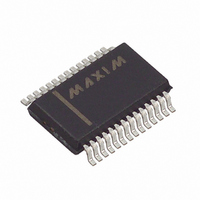MAX1403EAI+ Maxim Integrated Products, MAX1403EAI+ Datasheet - Page 35

MAX1403EAI+
Manufacturer Part Number
MAX1403EAI+
Description
IC ADC 18BIT LP 28-SSOP
Manufacturer
Maxim Integrated Products
Datasheet
1.MAX1403EAI.pdf
(36 pages)
Specifications of MAX1403EAI+
Number Of Bits
18
Sampling Rate (per Second)
480
Data Interface
QSPI™, Serial, SPI™
Number Of Converters
1
Power Dissipation (max)
21.45mW
Voltage Supply Source
Analog and Digital
Operating Temperature
-40°C ~ 85°C
Mounting Type
Surface Mount
Package / Case
28-SSOP
Number Of Adc Inputs
5
Architecture
Delta-Sigma
Conversion Rate
4.8 KSPs
Resolution
18 bit
Input Type
Voltage
Interface Type
Serial
Voltage Reference
External
Supply Voltage (max)
3 V
Maximum Power Dissipation
21.45 mW
Maximum Operating Temperature
+ 85 C
Mounting Style
SMD/SMT
Input Signal Type
Pseudo-Differential, Differential
Minimum Operating Temperature
- 40 C
Lead Free Status / RoHS Status
Lead free / RoHS Compliant
Unlike the 3-wire configuration, the 4-wire configuration
(Figure 18) has no error associated with lead resis-
tances, as no current flows in the measurement leads
connected to AIN1 and AIN2. Current source OUT1
provides the excitation current for the RTD, and current
source OUT2 provides current to generate the refer-
ence voltage. This reference voltage, developed across
R
remains ratiometric to the reference voltage. RTD temp-
co errors in the analog input voltage are due to the tem-
perature drift of the RTD current source and are
compensated for by the variation in the reference volt-
age. A common resistance value for the RTD is 100Ω,
generating a 20mV signal directly handled at the ana-
log input of the MAX1403. The voltage at OUT1 and
OUT2 can go to within 1.0V of the V+ supply.
No specific power sequence is required for the
MAX1403; either the V+ or the VDD supply can come
up first. While the latchup performance of the MAX1403
is good, to avoid latchup it is important that power be
applied to the MAX1403 before the analog input signals
(AIN_) or the CLKIN inputs. If this is not possible, then
the current flow into any of these pins should be limited
to 50mA. If separate supplies are used for the
MAX1403 and the system digital circuitry, then the
MAX1403 should be powered up first.
Figure 17. 3-Wire RTD Application
REF
, ensures that the analog input voltage span
RTD
R
R
R
L1
L2
L3
12.5k
______________________________________________________________________________________
AGND
OUT1
OUT2
AIN1
AIN2
V+
+3V, 18-Bit, Low-Power, Multichannel,
200µA
200µA
PGA
V
GAIN = 1 TO 128
DD
REFIN- REFIN+
Power Supplies
Oversampling (Sigma-Delta) ADC
MAX1403
DGND
MODULATOR
For best performance, use printed circuit boards with
separate analog and digital ground planes. Wire-wrap
boards are not recommended.
Design the printed circuit board so that the analog and
digital sections are separated and confined to different
areas of the board. Join the digital and analog ground
planes at only one point. If the MAX1403 is the only
device requiring an AGND to DGND connection, then
the ground planes should be connected at the AGND
and DGND pins of the MAX1403. In systems where mul-
tiple devices require AGND to DGND connections, the
connection should still be made at only one point. Make
the star ground as close to the MAX1403 as possible.
Avoid running digital lines under the device because
these may couple noise onto the die. Run the analog
ground plane under the MAX1403 to minimize coupling
of digital noise. Make the power-supply lines to the
MAX1403 as wide as possible to provide low-imped-
ance paths and reduce the effects of glitches on the
power-supply line.
Figure 18. 4-Wire RTD Application
RTD
R
REF
OUT2
REFIN+
OUT1
REFIN-
AIN1
AIN2
AGND
Grounding and Layout
+3V
V+
200µA
200µA
PGA
DGND
GAIN = 1 TO 128
V
DD
MODULATOR
MAX1403
35







